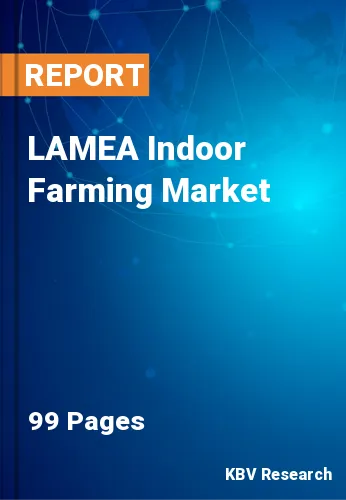The Latin America, Middle East and Africa Indoor Farming Market would witness market growth of 15.3% CAGR during the forecast period (2022-2028).
Among various increasing types in the indoor farming market, soil-based indoor farming dominates. When compared to conventional farming, its potential to improve the plant harvesting cycle is driving the expansion of the market. Glass or play greenhouses have a higher market value, but indoor deep-water culture systems are estimated to be in higher demand throughout the forecast years. Moreover, there is a growing demand for sustainable food production, which can be met by implementing indoor vertical farming approaches in agriculture.
The industry is anticipated to develop in response to rising consumer awareness of the benefits of eating fresh and high-quality food. The growing global population, particularly in emerging economies, has resulted in increased food demand, which is estimated to fuel the expansion of the indoor farming industry in the future years. There is an expansion of indoor farming in terms of the paucity of land for farming across the region.
According to World Bank data, South Asia is utilizing more than 90% of its potential arable land. In Sub-Saharan Africa, on the other hand, only approximately 20% of the theoretically arable land is cultivated. The adoption of indoor farming techniques is majorly high across the region. Kuwait produces a very low amount of its crops utilizing traditional agricultural practices in an area where water is scarce. Due to contemporary technology, a growing percentage of the country's fruit and vegetables come from indoor or hydroponic farms.
Moreover, according to the International food policy research institute, agriculture plays a significant role in the overall development of the Middle East. The agriculture sector contributes a total of 13% of the entire GDP of the Middle East. However, there are a number of challenges in crop production.
The Brazil market dominated the LAMEA Indoor Farming Market by Country in 2021, and would continue to be a dominant market till 2028; thereby, achieving a market value of $1,933.8 million by 2028. The Argentina market is estimated to witness a CAGR of 15.9% during (2022 - 2028). Additionally, The UAE market would display a CAGR of 15% during (2022 - 2028).
Based on Component, the market is segmented into Hardware (Lighting systems, Irrigation systems, Sensors, and Climate control systems) and Software (Web-Based and Cloud-Based). Based on Facility Type, the market is segmented into Greenhouses, Vertical Farms, and Others. Based on Crop Type, the market is segmented into Tomato, Lettuce, Bell & Chili Peppers, Strawberry, Leafy Greens, Herbs, Cucumber, Flowers & Ornamentals, and Others. Based on countries, the market is segmented into Brazil, Argentina, UAE, Saudi Arabia, South Africa, Nigeria, and Rest of LAMEA.
Free Valuable Insights: The Global Indoor Farming Market is Predict to reach $88.2 Billion by 2028, at a CAGR of 12.7%
The market research report covers the analysis of key stake holders of the market. Key companies profiled in the report include Orbia Advance Corporation, Certhon, General Hydroponics, Hydrodynamics International, Argus Control Systems Limited, Priva BV, LumiGrow, Inc., Richel Group, and Vertical Farm Systems Pty Ltd.
By Component
By Facility Type
By Crop Type
By Country
Our team of dedicated experts can provide you with attractive expansion opportunities for your business.

